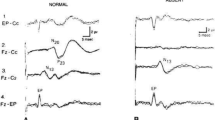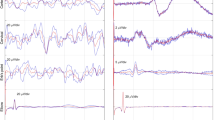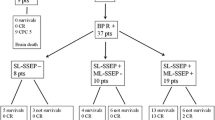Abstract
Background
To investigate the effect of mild hypothermia on conduction times and amplitudes of median nerve somatosensory evoked potentials (SEP) in patients after cardiopulmonary resuscitation (CPR).
Methods
Patients treated with hypothermia after CPR who underwent SEP recording during hypothermia and after rewarming were selected from a prospectively collected database. Latencies and amplitudes of N9 (peripheral conduction time, PCT), N13, and N20 were measured. The central conduction time (CCT) was defined as peak–peak latency N13–N20. Recordings of 25 patients were assessed by a second observer to determine the intraclass correlation coefficient (ICC).
Results
A total of 115 patients were included. The mean body temperature at SEP during hypothermia was 33.1 °C (SD 0.8) and after rewarming 37.1 °C (SD 0.8). Mean latencies of N9, N13, and N20 and mean CCT were longer during hypothermia. There were no consistent differences in amplitudes. There was an almost perfect ICC for assessment of latencies and amplitudes.
Conclusions
This study showed that PCT and CCT of median nerve SEP were prolonged during treatment with hypothermia after CPR compared with after rewarming. Amplitudes did not differ consistently.

Similar content being viewed by others
References
Wijdicks EF, Hijdra A, Young GB, Bassetti CL, Wiebe S. Practice parameter: prediction of outcome in comatose survivors after cardiopulmonary resuscitation (an evidence-based review): report of the Quality Standards Subcommittee of the American Academy of Neurology. Neurology. 2006;67:203–10.
Bouwes A, Kuiper MA, Hijdra A, Horn J. Induced hypothermia and determination of neurological outcome after CPR in ICUs in the Netherlands: results of a survey. Resuscitation. 2010;81:393–7.
Koht A, Schutz W, Schmidt G, Schramm J, Watanabe E. Effects of etomidate, midazolam, and thiopental on median nerve somatosensory evoked potentials and the additive effects of fentanyl and nitrous oxide. Anesth Analg. 1988;67:435–41.
Scheepstra GL, de Lange JJ, Booij LH, Ros HH. Median nerve evoked potentials during propofol anaesthesia. Br J Anaesth. 1989;62:92–4.
Sloan TB, Fugina ML, Toleikis JR. Effects of midazolam on median nerve somatosensory evoked potentials. Br J Anaesth. 1990;64:590–3.
Zandbergen EG, Hijdra A, de Haan RJ, et al. Interobserver variation in the interpretation of SSEPs in anoxic-ischaemic coma. Clin Neurophysiol. 2006;117:1529–35.
Markand ON, Warren C, Mallik GS, King RD, Brown JW, Mahomed Y. Effects of hypothermia on short latency somatosensory evoked potentials in humans. Electroencephalogr Clin Neurophysiol. 1990;77:416–24.
Markand ON, Warren C, Mallik GS, Williams CJ. Temperature-dependent hysteresis in somatosensory and auditory evoked potentials. Electroencephalogr Clin Neurophysiol. 1990;77:425–35.
Markand ON, Warren CH, Moorthy SS, Stoelting RK, King RD. Monitoring of multimodality evoked potentials during open heart surgery under hypothermia. Electroencephalogr Clin Neurophysiol. 1984;59:432–40.
Porkkala T, Kaukinen S, Hakkinen V, Jantti V. Effects of hypothermia and sternal retractors on median nerve somatosensory evoked potentials. Acta Anaesthesiol Scand. 1997;41:843–8.
Zeitlhofer J, Steiner M, Bousek K, et al. The influence of temperature on somatosensory-evoked potentials during cardiopulmonary bypass. Eur Neurol. 1990;30:284–90.
Deakin CD, Morrison LJ, Morley PT, et al. Part 8: advanced life support: 2010 international consensus on cardiopulmonary resuscitation and emergency cardiovascular care science with treatment recommendations. Resuscitation. 2010;81(Suppl 1):e93–174.
Peberdy MA, Callaway CW, Neumar RW, et al. Part 9: post-cardiac arrest care: 2010 American Heart Association guidelines for cardiopulmonary resuscitation and emergency cardiovascular care. Circulation. 2010;122:S768–86.
Rossetti AO, Oddo M, Logroscino G, Kaplan PW. Prognostication after cardiac arrest and hypothermia: a prospective study. Ann Neurol. 2010;67:301–7.
Bouwes A, Binnekade JM, Zandstra DF, et al. Somatosensory evoked potentials during mild hypothermia after cardiopulmonary resuscitation. Neurology. 2009;73:1457–61.
Bouwes A, Binnekade JM, Kuiper MA, et al. Prognosis of coma after therapeutic hypothermia: a prospective cohort study. Ann Neurol. 2012;71:206–12.
Jennett B, Bond M. Assessment of outcome after severe brain damage. Lancet. 1975;1:480–4.
Landis JR, Koch GG. The measurement of observer agreement for categorical data. Biometrics. 1977;33:159–74.
Fugate JE, Wijdicks EF, Mandrekar J, et al. Predictors of neurologic outcome in hypothermia after cardiac arrest. Ann Neurol. 2010;68:907–14.
Samaniego EA, Mlynash M, Caulfield AF, Eyngorn I, Wijman CA. Sedation confounds outcome prediction in cardiac arrest survivors treated with hypothermia. Neurocrit Care. 2011;15:113–9.
Leithner C, Ploner CJ, Hasper D, Storm C. Does hypothermia influence the predictive value of bilateral absent N20 after cardiac arrest? Neurology. 2010;74:965–9.
Buchthal F, Rosenfalck A. Evoked action potentials and conduction velocity in human sensory nerves. Brain Res. 1966;3:1–122.
Benita M, Conde H. Effects of local cooling upon conduction and synaptic transmission. Brain Res. 1972;36:133–51.
Guérit JM, Verhelst R, Rubay J, et al. The use of somatosensory evoked potentials to determine the optimal degree of hypothermia during circulatory arrest. J Card Surg. 1994;9:596–603.
Russ W, Sticher J, Scheld H, Hempelmann G. Effects of hypothermia on somatosensory evoked responses in man. Br J Anaesth. 1987;59:1484–91.
Tiainen M, Kovala TT, Takkunen OS, Roine RO. Somatosensory and brainstem auditory evoked potentials in cardiac arrest patients treated with hypothermia. Crit Care Med. 2005;33:1736–40.
Chiappa KH. Evoked potentials in clinical medicine. 3rd ed. Philadelphia: Lippincott-Raven; 1997.
Tortorici MA, Kochanek PM, Poloyac SM. Effects of hypothermia on drug disposition, metabolism, and response: a focus of hypothermia-mediated alterations on the cytochrome P450 enzyme system. Crit Care Med. 2007;35:2196–204.
Boisseau N, Madany M, Staccini P, et al. Comparison of the effects of sevoflurane and propofol on cortical somatosensory evoked potentials. Br J Anaesth. 2002;88:785–9.
Sloan TB. Anesthetic effects on electrophysiologic recordings. J Clin Neurophysiol. 1998;15:217–26.
Gendo A, Kramer L, Hafner M, et al. Time-dependency of sensory evoked potentials in comatose cardiac arrest survivors. Intensive Care Med. 2001;27:1305–11.
Nielsen N, Hovdenes J, Nilsson F, et al. Outcome, timing and adverse events in therapeutic hypothermia after out-of-hospital cardiac arrest. Acta Anaesthesiol Scand. 2009;53:926–34.
Acknowledgments
The authors would like to thank Jan Binnekade for help with statistical analysis and Thijs Boeree for creation of Fig. 1.
Conflict of interest
This study was supported by research grants from The Netherlands Brain Foundation, 14F06.48, and the Dutch Heart Foundation, 2007B039. Dr. Bouwes, Ms. Doesborg, Dr. Laman, Dr. Koelman, Dr. Imanse, Dr. Tromp, Dr. van Geel, Dr. van der Kooi, and Dr. Zandbergen report no conflict of interest. Dr. Horn has received research grants from The Netherlands Brain Foundation (14F06.48) and from the Dutch Heart Foundation (2007B039).
Author information
Authors and Affiliations
Corresponding author
Rights and permissions
About this article
Cite this article
Bouwes, A., Doesborg, P.G.G., Laman, D.M. et al. Hypothermia After CPR Prolongs Conduction Times of Somatosensory Evoked Potentials. Neurocrit Care 19, 25–30 (2013). https://doi.org/10.1007/s12028-013-9856-8
Published:
Issue Date:
DOI: https://doi.org/10.1007/s12028-013-9856-8




